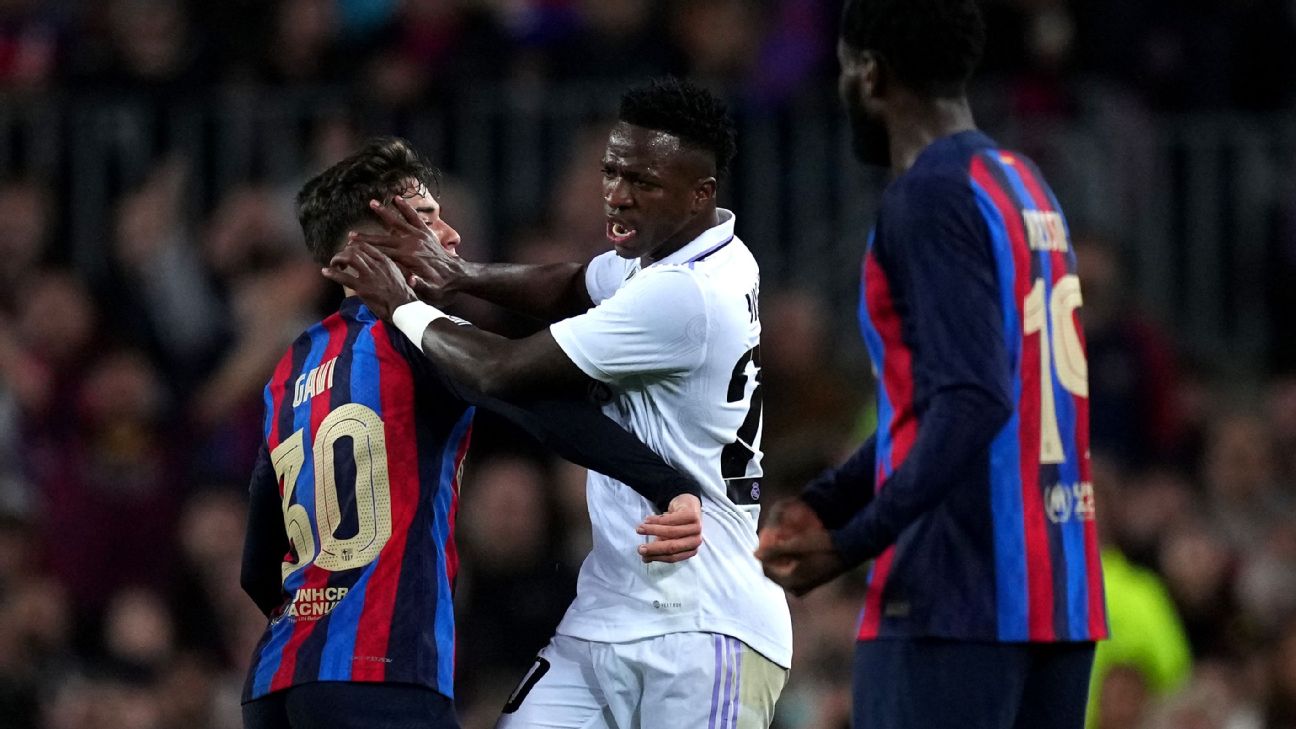Saturday’s El Clasico feels like something of a return … to a time when Real Madrid and Barcelona were evenly matched … to a time when Real Madrid and Barcelona were two of the five best teams in the world.
Outside of Manchester City, no other club in the world is clearly better than either of these two Spanish teams. As such, they’re both top-five favorites in the betting markets to win the Champions League. Either club could win it all, and it wouldn’t surprise anyone.
As for LaLiga, it’s close to 50-50 right now. Madrid have the slight edge because they have the slight edge in the table. Through 10 matches, Madrid have 25 points, Barca 24. Madrid have scored 21 goals, Barca 22. Madrid have allowed seven goals, Barca 10.
– Stream LIVE on ESPN+: Barca vs. Real Madrid, Saturday, 10 a.m. ET (U.S.)
Dig under the hood a little bit, and the minor edge for Real Madrid flips to a minor edge for Barcelona. Per Stats Perform, Barca have created 22.5 expected goals, or xG, while Madrid have created 19.0. Barca have conceded 9.8 xG, Madrid 10.6. Defending champ Barca have played a slightly easier schedule, though, so it’s basically a wash.
With the two teams as evenly matched as they’ve been in a long time, Saturday’s match warrants a breakdown into its component parts. Let’s compare Barcelona and Real Madrid across the five key areas that will decide the game: pressing, possession play, set pieces, transitions and finishing.
Key factor 1: Pressing
The story here is pretty simple. Barcelona press more aggressively and effectively than any team in LaLiga, while Real Madrid … don’t. At all.
There are a number of ways to measure pressing. Most popularly, there’s PPDA (passes allowed per defensive action), which essentially looks at how many passes a team allows in its attacking third before attempting a defensive action. Barcelona lead LaLiga with a PPDA of 8.70, while Real Madrid rank 14th with 12.83.
However, PPDA only really accounts for how much the team is trying to press, and how aggressive it’s attempting to be. It doesn’t quite show how effective it is at it. To get a clearer picture, we can bring in opposition pass-completion percentage. Barca, once again, rate top of LaLiga with opponents completing their passes just 75% of the time so far this season. Shockingly, Madrid’s opponents are completing 85.8% of their passes — the worst mark in the league.
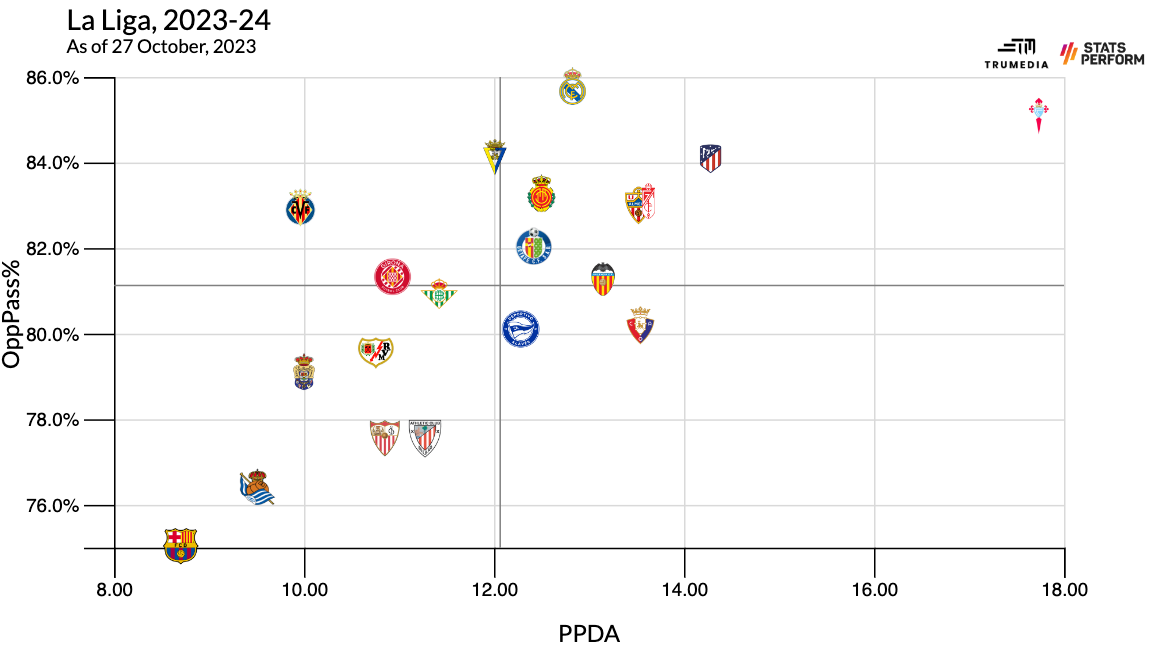
Some of that is schedule-related, but not much. The site Soccerment tracks a stat called “buildup-disruption percentage,” which looks at how frequently your opponent completed their passes against you compared to all of their other opponents. Barca’s opponents have completed their passes at a 5.67% lower rate, which ranks them third in the league, while Madrid’s opponents have seen their pass-completion rate increase by 2.17%, which is the third-worst rate in all of LaLiga.
Now, neither pressing nor, uh, not pressing is inherently good. But Barcelona are both pressing aggressively and effectively this season, and that usually leads to success. Meanwhile, there’s really just no world where Real Madrid allowing the highest pass-completion percentage in LaLiga over a 10-game stretch can ever really be a positive.
Advantage: Barcelona
Key factor 2: Possession
The name of the game here is, essentially, to move the ball into the opposition penalty area and keep it out of your own. In other words, we want to think about effective possession, rather than the kind of “possession for possession’s sake” possession that we saw, say, with the Spanish national team at the 2022 World Cup.
In terms of purely keeping the ball, though, Barca are unsurprisingly at the top of the league. This is what they do. They’ve maintained 68.8% of the ball across their 10 LaLiga matches thus far, and that’s more than 10 percentage points higher than the second-place team. In fact, the gap between Barcelona and Las Palmas in second is bigger than the gap between Las Palmas and Almeria in 11th.
Adjusted to only final-third possession, Barca still lead the league, and it’s with nearly the exact same mark as total possession: 68.4%. Madrid, meanwhile, rank third in overall possession (57.3%) and second in final-third possession (58.9%). Both teams have no problems moving the ball into the final third once they get it.
For Real Madrid, their leading progressive passer is Federico Valverde, who is completing nearly two more progressive passes per 90 minutes than he did last season. Toni Kroos and Aurelien Tchouameni are right around the same level, but passing is what they’re known for with the ball. Valverde was always more of a ball-carrying, off-ball-running midfielder — this passing increase is new.
Here’s a heat map of the locations from where he’s passing the ball into the attacking third:
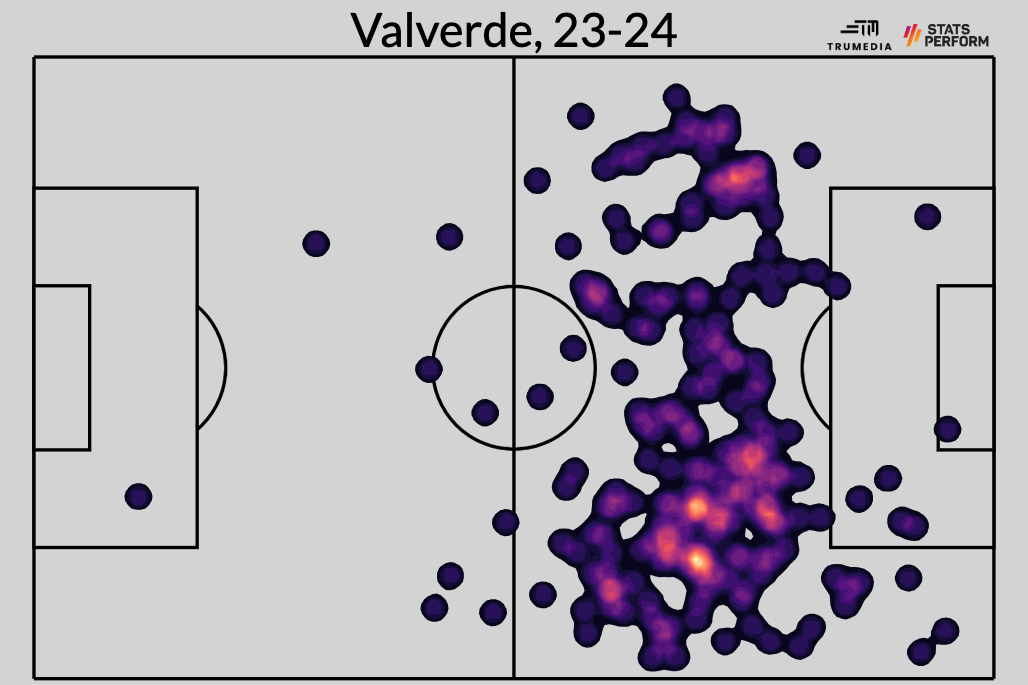
For Barca, the leading ball-progressor is Frenkie de Jong, who has only played half of the available minutes this season and might be out again on Saturday. Pedri, too, has barely played and will miss Saturday’s game. So Barca have instead moved the ball upfield through their defenders — mostly Andreas Christensen and Jules Koundé. The latter is one of 12 players in Spain to complete at least 60 progressive passes so far this season, and he’s completed more passes into the final-third than all but one player in LaLiga.
The problem for Barca, of course, is that Kounde has also been ruled out for Sunday’s match with an injury. In terms of players who generate possession control and the capacity to then create chances, Madrid have everyone available for Saturday’s match. While they don’t have a system or a clear tactical approach that creates more possession or control like Barcelona do, they simply just have a bunch of great players who do it anyway.
Even if everyone on Barcelona were healthy, Madrid would still have a significant talent edge in the midfield. Throw in the fact that their two forwards, Vinícius Júnior and Rodrygo, are two of the better ball carriers and off-ball runners in the world, and you have a team that’s able to move the ball into the opposition box at will. Despite controlling significantly less of the ball than Barca, Madrid average significantly more touches in the penalty area: 32.74 per-90, compared to 26.16.
On top of that, the combination of only playing two players in the front line and an extremely athletic four-man midfield simply makes it harder to play through Madrid. They’re also allowing a league-low number of touches inside their own box:

Another way to contrast the approach of the two teams (and see how they’ve become more like each other over time): Barcelona have completed the most dribbles, by far, of any team in LaLiga (120), while Madrid lead the way — by a significant margin — in the number of one-twos they play (41), per Soccerment.
Advantage: Real Madrid
Key factor 3: Set Pieces
While a free kick or a corner might be the decisive factor Saturday, there’s no real reason to believe that one team is more likely to execute on it than the other. Both teams are creating almost an identical number of xG from set pieces — 0.31 for Madrid, 0.28 for Barcelona — per game.
Despite having much more talent and much more of the ball than everyone else, neither club has taken advantage of one of the game’s great inefficiencies.
Advantage: Even
Key factor 4: Transition
Barcelona try to avoid transition. It’s why they keep hold of the ball so much and it’s why they press.
Per Soccerment, they’re averaging 0.03 xG per-90-minutes from counter-attacks — 17th-most in LaLiga. Now, some of that comes from their opponents, a weak slate of teams who sat behind the ball and mostly never gave them opportunities to get up a head of steam. But shockingly (read: not shockingly), Barca manager Xavi Hernandez has built a team that wants control of the ball, not bodies running up and down the field in open space.
Madrid, meanwhile, just naturally get out and run because of the players they have. With the explosiveness of Vinicius Junior, Rodrygo, Valverde and Jude Bellingham, you’d be foolish not to let them quickly attack into space. And Carlo Ancelotti’s whole deal as a manager is that he rarely tells his players or teams not to do something. If he doesn’t want you to do something, he’s just not going to put you on the field. As such, Madrid have generated 0.24 xG per 90 from counterattacks this season — more than all but two other teams.
On top of that, Barcelona have allowed 0.12 xG per-90 from opposition counters, which ranks just 15th in the league. This, then, seems like the most likely area to decide Saturday’s match. If Barca can press Madrid’s countering opportunities to death before they even begin, their defense should be comfortable. But if Madrid can get out and run, it could be a long day for the hosts.
Advantage: Real Madrid
Key factor 5: Finishing
Despite that domination of the penalty areas, Madrid are both creating fewer xG and allowing more xG than Barcelona. Why is that?
We’ll start with the latter: Barcelona have better defenders. They had the best defense in the league last season by a wide margin, and all of those players are still here today. Kounde, of course, won’t be on Saturday, but Ronald Araújo is back in action after suffering a hamstring injury in August and missing most of the season so far. Had he too been healthy for most of the season, I suspect there’d be an even bigger gap between the two sides defensively.
Madrid, meanwhile, lost their best center back, Éder Militão, to a season-ending ACL tear back in August. Dani Carvajal used to be one of the best fullbacks in the world, but at 31, he’s become quite inconsistent. The Antonio Rüdiger-David Alaba pairing looks great on paper — Alaba’s savvy, paired with Rudiger’s aggression — but it just hasn’t produced requisite results yet. And Madrid’s left back slot — mostly occupied by either Fran García or Ferland Mendy — is the weakest specific position in either team’s lineup. Playing Eduardo Camavinga here, out of position, might be Madrid’s best option.
The main reason Madrid have only allowed a measly seven goals is that their goalkeepers have been fantastic. When Thibaut Courtois went out injured for the season, first Andriy Lunin stepped in and saved 1.1 goals more than expected, per data from FBref, and then Kepa Arrizabalaga arrived on loan from Chelsea, took over and has since saved 2.3 goals more than expected. Combined, those 3.4 goals saved above expectation lead LaLiga.
And the main reason that Barcelona trail behind Madrid in goals allowed is that Marc-André ter Stegen has been simply average so far. Almost perfectly so. He’s let in 10 goals from shots worth 9.9 expected goals. Although Madrid has the better shot-stopping so far this season, I wouldn’t expect that to continue for the rest of the season, or Saturday. MATS is one of the best keepers in the world, and it’s been that way for a while.
Although Kepa has quietly been a solid shot-stopper for a couple partial seasons running now, he’s still allowed more goals than expected over the course of his career. My guess is he’s become a league-average shot-stopper at this point in his career — a massive improvement from where he was at Chelsea, but still significantly below where he’s performed for Madrid.
 Real Madrid with Kepa Arrizabalaga in goal: Orange dots are goals, purple dots are saves.
Real Madrid with Kepa Arrizabalaga in goal: Orange dots are goals, purple dots are saves.
On the other end, Madrid’s inability to efficiently create quality chances from all of that penalty-area position stems simply from the fact that they don’t have a player whose main job is to make the runs that would allow his team to efficiently create chances from penalty-area possession.
If you had a team with four uber-skilled midfielders and two wide forwards who loved to dribble, your problem wouldn’t be moving the ball forward or even getting it into the box. Your problem would be — and is, for Madrid — converting all of that high possession into goals.
“Problem” belongs in quotes here, though, because Madrid still rank second in non-penalty xG per 90 minutes. They’re leading the league in shots attempted with 17.8 per 90 minutes, but that’s paired with a league-average level of shot-quality: 0.1 xG per shot. They’ve turned 17.6 non-penalty goals in 21 goals mainly because of, well, this:
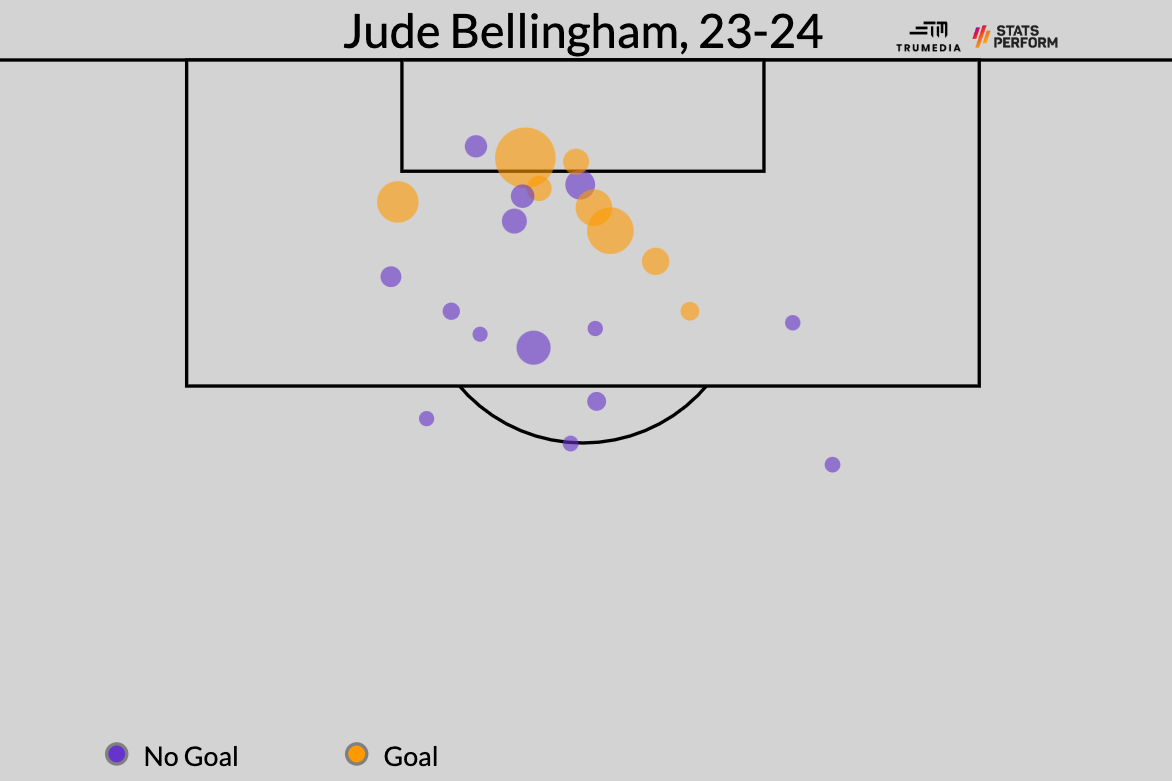
Bellingham, a midfielder, is currently leading LaLiga in goal-scoring. It’s a fluke, but it’s also not. Normally, goal-scoring midfielders will waste a ton of possessions with longer shots from outside the penalty area. As you can see above, almost all of Bellingham’s attempts are coming from inside the box.
If Bellingham keeps getting shots from these areas, he’s going to score double-digit goals every season he stays healthy. He’s just not going to continue to exceed his xG (4.05) by this much. No one will ever finish twice as well as the xG model suggests for long. The best ever, Lionel Messi, only exceeded it by about 25% over the course of his career.
Over Bellingham’s 186 competitive club games in Stats Perform’s database, he’s scored 37 goals from 33.3 xG. In other words, all of the overperformance comes from this season alone. His goal-scoring just isn’t going to continue at this rate. But as previously mentioned, he’s a midfielder. He’s first on the team in non-penalty xG, second in open-play expected assists, third in progressive passes, second in counter-pressing actions, first in through balls, first in successful dribbles and first in fouls won. Even when the goals start to dry up, he’ll still be one of the most valuable players in the world.
Flip this story inside out, and you get Barcelona. They’re not taking as many shots as Madrid, but they’re leading LaLiga in non-penalty xG with 21.7 because they create the second-best shots (0.14 xG per shot) of any team in Spain. The main reason they’re more efficient around the box than Madrid: They have the best center forward of his generation in Robert Lewandowski.
Lewandowski’s main skill is the main thing Madrid don’t do all that well: getting off shots in the center of the penalty area. Unlike Bellingham, though, his finishing has been a bit wayward so far this season: four non-penalty goals from 5.36 xG.
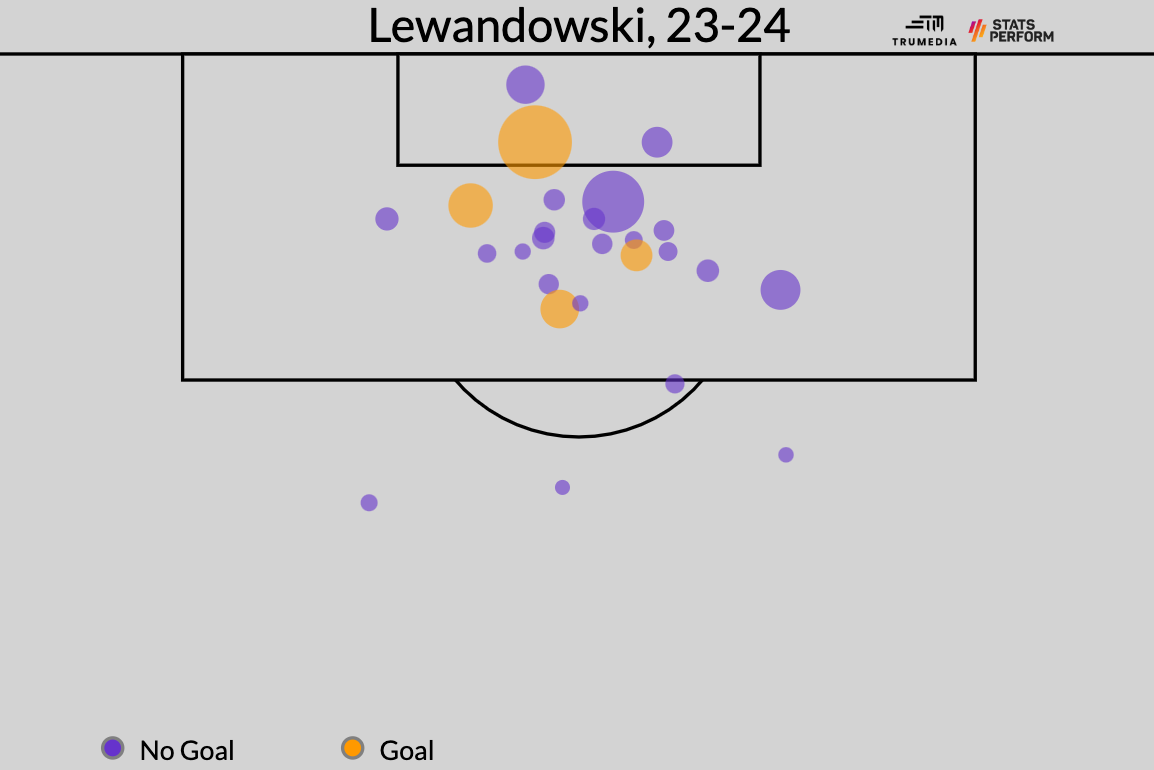
Lewandowski, of course, might also miss Saturday’s match. And without him, Barca’s slower, more deliberate style just doesn’t work as well because there isn’t someone to take advantage of all of that possession in the final-third.
Advantage: Even
With how evenly matched the two sides seem, how could injuries to their best defenders, midfielders and attackers not push Barcelona slightly behind Madrid? Thankfully, for Xavi and Co., the match is in Barcelona, so perhaps home-field advantage is enough to make up for the talent gap we’ll see between the two sides this weekend.
At full strength, Barcelona would be the favorites, but as things stand, the most likely outcome seems like a draw.
The match seems like it’ll hinge on these two interrelated questions: Without their best ball-progressors and potentially without their best shot-getter, will Barcelona be able to take advantage of the attacking pressure they’re likely to put on Madrid’s shaky backline? Or will Madrid be able to hold out, draw Barcelona forward, entice them to press and then get Vinicius Junior, Rodrygo and Bellingham breaking into the box?
